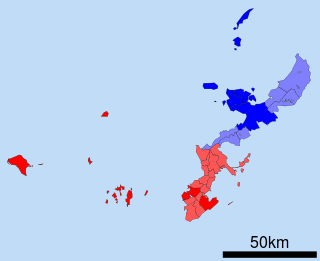Kunigami language
| Kunigami | |
|---|---|
| 山原言葉/ヤンバルクトゥーバ Yanbaru Kutuuba | |
| Native to | Japan |
| Region | Northern Okinawa Island |
Native speakers | 5,000 (2004)[1] |
| Language codes | |
| ISO 639-3 | xug |
| Glottolog | kuni1268 |
 Kunigami | |
The Kunigami or Northern Okinawan language (Yanbaru Kutuuba (山原言葉/ヤンバルクトゥーバ)) is a Ryukyuan language of northern Okinawa Island in Kunigami District and city of Nago, otherwise known as the Yanbaru region, historically the territory of the Hokuzan kingdom.
The Nakijin dialect is often considered representative of Kunigami, analogous to the Shuri/Naha dialect of Central Okinawan. The number of fluent native speakers of Kunigami is not known. As a result of Japanese language policy, the younger generation mostly speaks Japanese as their first language.
Location
In addition to the northern portion of Okinawa Island, Kunigami is spoken on the small neighboring islands of Ie, Tsuken and Kudaka.[2]
Scope and classification
Glottolog, following Pellard (2009), classifies Kunigami with Central Okinawan as the two Okinawan languages. Ethnologue adds Okinoerabu and Yoron; these (along with all other languages of the northern Ryukyus) are classified as Amami languages by Glottolog. The UNESCO Atlas of the World's Languages in Danger, following Uemura (2003), includes Okinoerabu and Yoron as varieties of Kunigami.[3]
Folk terminology
The speakers of Kunigami have various words for "language", "dialect", and "style of speech". For example, linguist Nakasone Seizen (1907–1995) stated that the dialect of his home community Yonamine, Nakijin Village had (corresponding Standard Japanese word forms in parentheses): /kʰu⸢tsʰii/ (kuchi), /hut˭uu⸢ba/ (kotoba) and /munu⸢ʔii/ (monoii). The language of one's own community was referred to as /simaagu⸢tsʰii/ or /sima(a)kʰu⸢t˭uu⸣ba/.[4] The Yonamine dialect was part of Nakijin's western dialect called /ʔirinsimaa kʰut˭uba/.[5] The northern part of Okinawa was colloquially known as Yanbaru and hence its language was sometimes called /jˀan⸢ba⸣rukʰut˭uuba/.[6]
Phonology
Like most Ryukyuan languages north of Central Okinawan, Kunigami has series of so-called "tensed" or "glottalized" consonants. While the nasals and glides are truly glottalized,[citation needed] the stops are tenuis [C˭], in contrast to the aspiration of the "plain" stops [Cʰ].[7] Kunigami is also notable for the presence of an /h/ phoneme separate from /p/, which is believed to be the historical source of /h/ in modern dialects of the Japanese language.[what is the source of Kunigami /h/?] Thus, for example, the Nakijin dialect of Kunigami has /hak˭áí/ (light, a lamp, a shōji),[8] which is cognate with Japanese /akárí/ (light, a lamp); the Kunigami form is distinguished from its Japanese cognate by the initial /h/, tenuis /k˭/, and elision of Proto-Japonic *r before *i. The Kunigami language also makes distinctions in certain word pairs, such as Nakijin dialect /k˭umuú/ (cloud) and /húbu/ (spider), which are more similar (/kúmo/ and /kumó/) in Japanese.
Morphology
One notable difference in the use of certain morphological markers between Kunigami language and Standard Japanese is the use of the /-sa/ form as an adverb in Kunigami: e.g. Nakijin dialect /tʰuusá pʰanaaɽít˭un/, which is equivalent to Standard Japanese toókú hanárete irú ("It is far away"). In Standard Japanese, the /-ku/ form is used adverbially, while the /-sa/ form is used exclusively to derive abstract nouns of quality ("-ness" forms) from adjectival stems.
References
- ^ Kunigami at Ethnologue (18th ed., 2015) (subscription required)
- ^ Nakamoto Masachie 中本正智 (1981). Zusetsu Ryūkyū-go jiten 図説 琉球語辞典 (in Japanese). p. 26.
- ^ "Kunigami". UNESCO. Retrieved 1 February 2014.
- ^ "Nakijin Dialect Dictionary: kotoba" (in Japanese). Retrieved 1 February 2014.
- ^ "Nakijin Dialect Dictionary: Nakijin-hōgen gaisetsu" (in Japanese). Retrieved 1 February 2014.
- ^ "Nakijin Dialect Dictionary: yanbaru kotoba" (in Japanese). Retrieved 1 February 2014.
- ^ Samuel E. Martin (1970) "Shodon: A Dialect of the Northern Ryukyus", in the Journal of the American Oriental Society, vol. 90, no. 1 (Jan–Mar), pp. 97–139.
- ^ Acute accent indicate a high tone
